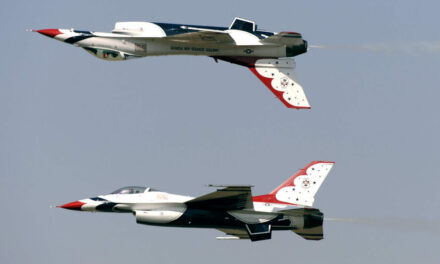We support our Publishers and Content Creators. You can view this story on their website by CLICKING HERE.
If ever a subject was suited for IMAX, it has to be the U.S. Navy’s elite demonstration squadron, the Blue Angels — known for jaw-dropping maneuvers with four F/A-18 jets flying together at 400 miles per hour, only inches apart.
Now actor and producer Glen Powell, known for depicting fighter pilots in “Top Gun: Maverick” and “Devotion,” and producer J.J. Abrams of the “Mission: Impossible” franchise have collaborated to capture “The Blue Angels” up close and personal. The documentary film, which many museums and specialty IMAX screens plan to run throughout this summer, just landed on Prime Video.
Abrams, known for his hit “Star Trek” films, contrasts his usual special effects shots — “You plan these moves and it’s cool, but it’s not real” — with what he witnessed with the Blue Angels. “What these pilots do, it’s real. There are no second chances. It is truly a life and death demonstration.”
In an interview with Capt. Greg Wooldridge, longtime commander of the Blue Angels, he told me the film is visually “unparalleled and unmatched” because of the production crew’s expertise.
“They got Kevin LaRosa, who did aerial coordination on ‘Top Gun: Maverick,’ into a helicopter with these Sony Venice cameras and the Phantom high-speed camera that (films) a thousand frames a second,” said Wooldridge. “It’s never happened before, and it will last forever.”
Film director Paul Crowder (“Once In A Lifetime”) noted their production helicopter — with a battery of bulky cameras — was flown in formation with the Blue Angels’ maneuvers, which had never been done before. “To get the Navy to approve that and to get the pilots comfortable enough to trust us to put a helicopter in the middle of their formation, those were the real difficulties.”
Similar to the recent Tom Cruise hit film, audiences get to see the pilots’ camaraderie, teamwork, and a bit of competitive bravado among them. Amid the spectacular visuals and behind-the-scenes squadron meetings, the film also spotlights the sacrifices of military families.
Service and Spectacle
In a fleet of 3,700 Navy pilots, only six are assigned to the Blue Angels, each for two years. With flight leader Capt. Brian Kesselring at the helm, viewers meet two “newbies,” Chris Kapuschansky and Scott Goossens, who must learn the squadron’s complex choreography.
Filmmaker Crowder, whose crew spent a year with the pilots, was impressed by what he saw.
“What the newbie pilots go through when getting into this team, it’s a lot of jargon to get up to speed on,” said Crowder. “They have to go through high-g training in the centrifuge. And they’re going from fleet flying to flying 18 inches apart — it’s very different, they’ve never flown that close to a jet.”
For myself, nearly every summer my dad loaded me and my brothers into the family van and took us to watch an air show. My wife — an “Air Force brat,” as she says — helps our family continue this tradition, marking air shows on our kids’ calendar months in advance. The sights and sounds of supersonic jets and massive engines make for a memorable afternoon, but the crowds seem to have thinned over the years.
In “The Blue Angels” film, audiences who’ve only seen these maneuvers from the ground suddenly see it all from the cockpit and helicopter shots that are captured midair in high-def slow motion.
If air shows give a window into life on base, this documentary brings audiences a few steps closer. Much of the flight action occurs at the squadron’s training base, Naval Air Facility El Centro in southern California — which will look familiar from “Top Gun” — and also at the Blue Angels’ home base in Pensacola.
In the Florida Panhandle, the film slows its breakneck pace to go into the home of Capt. Kesselring; his Marine officer wife, Ashley; and their two young children.
“Sure, they’re elite pilots, but they’ve got life going on in the background,” said Crowder. “You’ve got kids to bring up. Some of the squadron personnel were in the midst of getting married. We tried to show as much of that as we could.”
“They strive for perfection in military life, and they take it seriously because they have families who are depending on them.”
A Larger Purpose
Capt. Wooldridge, an executive producer on the film, is the only commanding officer in U.S. Naval history to lead the Blue Angels on three separate tours.
Despite his legendary leadership of the demonstration squadron, he is effusive about the meticulous work of everybody “on the team,” which the aviators depend on.
‘You might be called ‘boss,’” Wooldridge told me. “But you’re no more important than the supply officers and maintenance crews and every enlisted person on base. Because if each person doesn’t do their job to the best of their ability, then everything breaks down.”
Wooldridge shows up in a few scenes as the current leader, Capt. Kesselring, plays an integral role in choosing the next commanding officer and new pilots on the squadron. While only candidates with 3,000 flight hours and who’ve commanded a tactical jet squadron can apply, “The Blue Angels” shows potential flight leaders assembling from across the globe.
“It’s an honor to get to represent the entire Navy and Marine Corps in front of the American public for a full two years,” said Wooldridge. “You realize how important it is for the Navy to present themselves at their best. It’s fun to fly the jets, but what we get to do is also important.”
From the training regimen with long grueling days to being apart from family for months at a time, the Blue Angels’ work is shown as far from glamorous. But the squadron also aims for their “rock star” shows to educate on the nature of military service for one’s country.
Wooldridge speaks with appreciation for Navy personnel serving on the front lines. “They’re struggling out there, at sea for eight months or longer. Getting to be the point of contact between them and the American public, we love doing it.”
“The Blue Angels” is streaming on Prime Video and showing in select theaters.
Josh Shepherd covers culture, faith, and public policy for several media outlets including The Stream. His articles have appeared in Christianity Today, Religion & Politics, Faithfully Magazine, Religion News Service, and Providence Magazine. A graduate of the University of Colorado, he previously worked on staff at The Heritage Foundation and Focus on the Family. Josh and his wife live in the Washington, D.C. area with their two children.

 Conservative
Conservative  Search
Search Trending
Trending Current News
Current News 




